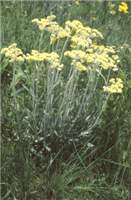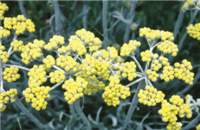Common names:
Cholocholo, Isidwabasokhovu, umgademthina. (Z); Hottentot's tea (E), Hottentottee (A), Mohlomela-tsie (SS), Umagada-emthini (Z)
Origin of name:
nudi = hairless; folium = leaves.oxy = sharp, acute; phyllum = leaf
Diagnostic characters:
Broad leaves slightly hairy belowWhite bractsCompact inflorescences
Description:
Perennial herb, stock woody, flowering stem usually solitary, simple, up to c. 600 mm tall, leafy below, pedunculoid upwards, thinly woolly. Radical leaves up to 350 x 40 mm, about half the length petiolar, blade elliptic to ovate, abruptly or gradually narrowed to the slender petiole, apex acute, margins often undulate, upper surface scabridulous, lower white-felted, 3-, rarely 5-nerved, tertiary nerves not or faintly visible; cauline leaves similar to radical, but soon sessile and cordate-clasping, passing into distant acuminate bracts. Heads homogamous, campanulate, c. 6�7 mm long and as broad, many in a compact, flat-topped corymbose panicle. Involucral bracts in c. 4 series, graded, closely imbricate, woolly at the base, tips ovate, subobtuse, more or less opaque, outer purplish or reddish, inner tipped white or creamy, equaling the flowers, scarcely radiating. Receptacle with fimbrils at least equaling the ovaries. Flowers 18�29. Achenes not seen, ovaries glabrous. Pappus bristles scabrid, bases lightly fused, also cohering by patent cilia.
Flowering between August and January.
Distribution:
Grows in grassland or, in the W. Cape, among restiods. Ranges from Zimbabwe, Malawi and Mozambique to Limpopo, Mpumalanga and Swaziland Lowveld and Zululand, through the coastal and Midlands districts of KwaZulu-Natal, Transkei and Eastern Cape to Caledon in the W. Cape.
Grassland, Savanna and Fynbos Biomes.
Notes:
Very closely allied to H. pallidum, but distinguished by its triplinerved (rarely 5-nerved) leaves with tertiary veins not or scarcely visible, and heads with graded involucral bracts, the outer ones tinged pink to purplish; H. pallidum has leaves with 5�7 main veins, tertiary veins clearly visible, and involucral bracts subequal and pale-coloured. Intermediate specimens occur; see note under H. pallidum. See also under H. allioides.Taxonomy:
Literature:
Helichrysum nudifolium var. oxyphyllum DC., Prodr. 6: 199 (1838); Harv. in F.C. 3: 241 (1865); Hilliard & Burtt in Notes R. bot. Gdn Edinb. 32,3: 353 (1973); Hilliard, Compositae in Natal 179 (1977).
Type:
Cape, Gouritz River, Burchell 4733 (G-DC, holo.; K, iso.).
Synonym(s):
Helichrysum oxyphyllum DC., Prodr. 6: 199 (1838); Harv. in F.C. 3: 241 (1865); Hilliard & Burtt in Notes R. bot. Gdn Edinb. 32,3: 353 (1973); Hilliard, Compositae in Natal 179 (1977). Type: Cape, Gouritz River, Burchell 4733 (G-DC, holo.; K, iso.).
Gnaphalium crispum L.f., Suppl. 363 (1781), non L. (1767). G. elatum Lam., Encycl. 2: 742 (1788), non Helichrysum elatum DC. (1838). G. undatum J. F. Gmel., Syst. Veg. 2: 1213 (1792), nom. illegit. Helichrysum undatum Less., Syn. Comp. 298 (1832), nom. illegit. Type: Cape of Good Hope, Thunberg s.n.
Helichrysum undatum var. elongatum DC., Prodr. 6: 199 (1838). Type: Cape, Zuurberg, Dr�ge 5740 (G-DC, holo.).
H. allioides var. flavo-rubens DC., Prodr. 6: 198 (1838). Type: Cape, Uitenhage, Zuurberg, Ecklon 1878 (G-DC, holo.).
H. amoenum Moeser in Bot. Jb. 44: 268 (1910). Type: Cape, Langeberg near Zuurbraak, 1 500 ft, 18 i 1893, Schlechter 2116 (Z, holo.; BM; J, iso.).
Vouchers:
Esterhuysen 16923 (BOL; NBG); Flanagan 868 (PRE; SAM); Galpin 8363 (PRE); Hutchinson 1545 (BOL); Pott 5405 (E; NU); Strey 8126 (NU).


